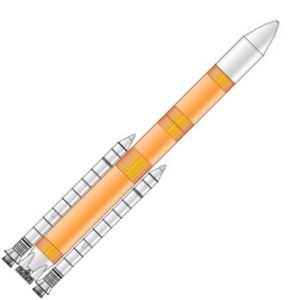
Home - Search - Browse - Alphabetic Index: 0- 1- 2- 3- 4- 5- 6- 7- 8- 9
A- B- C- D- E- F- G- H- I- J- K- L- M- N- O- P- Q- R- S- T- U- V- W- X- Y- Z
Ares V
 Cargo LV Credit: © Mark Wade |
AKA: Cargo Launch Vehicle. Status: In development. Payload: 124,600 kg (274,600 lb). Thrust: 32,629.61 kN (7,335,427 lbf). Gross mass: 3,360,000 kg (7,400,000 lb). Height: 109.20 m (358.20 ft). Diameter: 8.40 m (27.50 ft). Apogee: 160 km (90 mi).
The Ares Cargo LV would use two five-segment versions of the shuttle's RSRM rocket motors as lateral boosters (the standard RSRM had four segments). The core would be a stretched version of the shuttle's external tank, with five RS-68 engines engine mounted on the base (the first September 2005 version of the design used expendable versions of the shuttle SSME engine). This basic vehicle could deliver 130 metric tons to low earth orbit. However, normally it would be used with an upper stage for manned lunar missions. On such missions the basic vehicle would separate from the upper stage while still suborbital. The upper stage, also based on the external tank but powered by one J-2S engines, would insert itself into an earth parking orbit. Its payload would be a lunar lander. After up to thirty days in orbit, a manned Orion spacecraft would rendezvous and dock with the upper stage and lander. The upper stage would launch the lander and CEV toward the moon, then separate.
For later manned Mars expeditions, four launches of the Ares V would be required to assemble the Mars spacecraft in low earth orbit.
LEO Payload: 124,600 kg (274,600 lb) to a 160 km orbit at 28.00 degrees. Payload: 54,600 kg (120,300 lb) to a translunar trajectory.
Family: heavy-lift, orbital launch vehicle. Country: USA. Spacecraft: LSAM. Stages: Ares Stage 2, Ares Stage 1, RSRM. Agency: NASA.
Back to top of page
Home - Search - Browse - Alphabetic Index: 0- 1- 2- 3- 4- 5- 6- 7- 8- 9
A- B- C- D- E- F- G- H- I- J- K- L- M- N- O- P- Q- R- S- T- U- V- W- X- Y- Z
© 1997-2019 Mark Wade - Contact
© / Conditions for Use